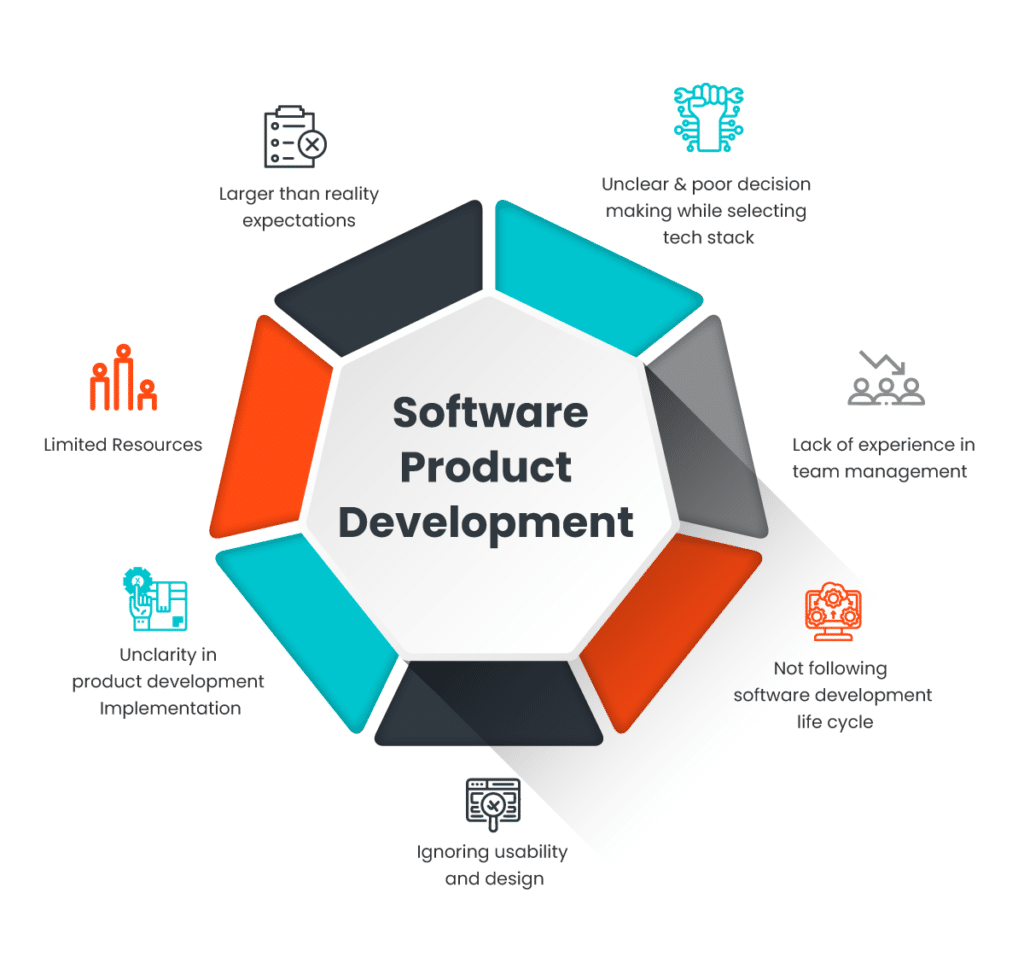Starting and building successful startups in the world of software product development is no easy feat. The journey is filled with challenges that can test even the most determined entrepreneurs. One of the biggest hurdles is the scarcity of resources like funding and skilled team members. These can slow down progress and hinder growth.
Moreover, the market is constantly evolving, and startups must quickly adapt to changing customer needs and industry trends to stay relevant. This requires a high level of flexibility and innovation, which can be difficult to maintain amidst the pressures of competition. Overcoming these obstacles demands a blend of creativity, perseverance, and the ability to make smart decisions that can lead the startup toward success.
Understanding and addressing challenges early on can help startups in software product development. In this blog, we’ll discuss common hurdles and effective strategies to overcome them. By sharing insights and solutions, we aim to equip aspiring entrepreneurs with the knowledge they need to navigate the industry’s complexities and secure success for their startups.
Let’s explore these challenges and turn them into opportunities for growth and achievement.
Software Product Development Challenges & their Solutions:
Product development sets the foundation of a tech startup because it involves creating the software product that the company will offer to its customers. Being aware of the challenges early on is essential because it helps the startup prepare and strategize.
1. Unclarity in product development implementation:
Not having clarity on product development implementation can seriously hinder software development efforts. Confusion or lack of clear direction leads to wasted time, resources, and missed deadlines, making it hard to meet customer expectations and stay competitive. It can also affect teamwork, resulting in miscommunication and a product different from what customers need. Such things can trigger budget overruns and dissatisfaction among stakeholders, which may hinder the startup’s progress.
How to fix it?
Proper planning is crucial for software development as a wrong step can waste time and incur high costs. An effective product roadmap is a way out. After the roadmap is done, setting up well-defined goals and clearly communicating those with the team is important.
Apart from these, many tech companies which offer software development services for startups are there in the market. Outsourcing tech needs to these teams can be beneficial as they have the experience of dealing with this kind of project management.
Key takeaways:
- Careful planning
- Clear communication
- Setting well defined goals
- Outsourcing software development
2. Limited resources:
Entrepreneurs need more resources and workforce to invest in the tools, employees, and technologies essential for effective product development. A lack of resources can impede their process of software development in startups. It may cause some missed market opportunities and delays in new product launch.
Implementing thorough testing and quality control procedures is also a costly affair. This could lead to releasing of mediocre products with flaws and vulnerabilities.
How to fix it?
Managing limited resources in a startup while achieving growth requires smart and strategic approaches. Firstly, startups should prioritize their spending on essential product development and customer acquisition activities. This means hiring key talents, investing in efficient tools, and optimizing operational costs. Secondly, leveraging outsourcing and partnerships can empower startups with specialized skills and resources without inviting full-time expenses.
Embracing a lean and agile mindset can help startups iterate quickly, identify what works, and avoid wasting resources on unnecessary features. They can benefit from maintaining open communication and fostering a strong company culture. It will motivate employees, create a collaborative environment, and maximize productivity and creativity with the available resources. In the long run, these will help startups achieve sustainable growth.
Key takeaways:
- Prioritize spending
- Leverage outsourcing
- Adapting lean and agile mind-set
- Investing in company culture
3. Larger than reality expectations:
When startups set unrealistic goals, they waste time and resources. Their products do not meet exaggerated expectations only to trigger disappointment and frustration in stakeholders and affect the business detrimentally.
Ideas can start as inspiring and motivating. They can move entrepreneurs to create an app with numerous cool features and functionalities. But building a complex and multifunctional app right from the beginning is impractical. Entrepreneurs should create a solid foundation for the product and then gradually add features based on user feedback. The method can ensure a sustainable development process and success.
How to fix it?
Businesses have to be pragmatic. They should start by defining clear and achievable goals for the software product. Then, develop a Minimum Viable Product (MVP) with only the essential features to validate the concept and gather user feedback.
Developers must prioritize features based on customer needs and market demands to deliver value early on. It requires an iterative development process, feedback, and continuous product improvement based on real-world insights. By managing expectations, staying customer-centric, and incrementally adding features, startups can build a more sustainable software product aligned with actual market requirements.
Key takeaways:
- Building MVP first.
- Prioritize features based on customer needs.
- Gather feedback.
- Align with actual market requirements.

4. Poor decision making while selecting tech stack:
The tech stack is the set of technologies and tools used to build a software product. Wrong tech stacks can cause compatibility issues with other existing product components. This can lead to frequent bugs, slower development progress, and increased maintenance costs.
Outdated or unsupported technologies can prevent startups from scaling and adapting to future needs. Finding skilled developers can also become difficult if the tech stack is old. These can slow a startup’s growth, affect user experience, and increase the risk of the product becoming obsolete in the rapidly evolving tech landscape.
How to fix it?
The right tech stack can secure success for a product, ensure sustainability and maintain its competitiveness. Startup founders must understand the specific requirements of the software product and market needs. They should analyze various technologies and frameworks and assess their pros and cons against considerations like scalability, community support, and future updates. In such cases, experienced developers or tech experts can provide invaluable insights and help stakeholders make informed decisions.
Adopting technologies with a proven track record and widespread adoption is better to ensure access to a larger pool of skilled developers who can contribute to your project.
Building an MVP is a practical way to validate the feasibility of the chosen tech stack before fully committing. Stakeholders must do comprehensive research and get feedback to avoid pitfalls of poor tech stack choices and lay a solid foundation for the software product.
Key takeaways:
- Understand requirements of software products.
- Gather information about current technologies & existing frameworks.
- Seek help from experts.
- Make informed decisions.
- Build an MVP.
5. Lack of experience in team management:
Team management can be decisive in determining the success of a startup software development project. If the management is inefficient, it can impact efforts, trigger missed deadlines, and reduce productivity by making it difficult to coordinate tasks, set clear objectives, and ensure proper communication among team members.
Inexperienced managers struggle to identify and address team issues, resulting in low morale among team members. This could make the product development process chaotic and ineffective, affecting the startup’s ability to deliver a high-quality software product on time and within budget.
How to fix it?
Fixing this issue requires several proactive steps. First, onboard experienced mentors or hire a skilled project manager who can provide valuable insights and leadership. Then, invest in management training for startup founders and team members to enhance their team management skills. Finally, build a culture of open communication and regular feedback within the team to identify and address challenges early on.
Agile methodologies and project management tools can improve coordination and task tracking. Teams always benefit from a supportive and collaborative work environment where members can learn from each other’s experiences and can contribute to overcome this challenge. Software development efforts of such teams are more effective and experience increased chances of success.
Key takeaways:
- Guidance from experienced mentors.
- Invest in training.
- Encourage open communication work culture.
- Embrace agile methodologies.
- Create a supportive & collaborative work environment.
6. Not following the software development life cycle:
Overlooking the importance of the software development lifecycle can have severe consequences in a startup ecosystem. The software development life cycle is a structured process that guides a software product’s planning, development, testing, and deployment. Neglecting this essential framework can lead to chaos and inefficiency in the development process, resulting in a product plagued with bugs and usability issues, which can harm the startup’s reputation and customer satisfaction.
Without a clear roadmap, projects may get delayed and costs overshoot, hampering the startup’s ability to take their product to the market in time and compete. The lack of a defined development lifecycle can make tracking progress, identifying bottlenecks, and prioritizing tasks challenging, leading to project management difficulties. When startups disregard the software development lifecycle, they compromise their product’s success and fail to meet their business goals.
How to fix it?
Addressing the issue is crucial for a startup to be more organized and systematic. Founders can start by familiarizing themselves with the key stages of the software development lifecycle like planning, design, development, testing, and deployment. It will help them to create a clear roadmap, assign roles and responsibilities, set realistic milestones, facilitate effective communication and collaboration, track progress, and ensure timely completion of tasks.
Startups should adopt agile methodologies. They allow startups to iterate quickly and respond to feedback. It improves the quality of the software product. Startups can further implement project management tools to streamline tasks and improve overall efficiency. By prioritizing the software development lifecycle and integrating it into the development process, they can ensure a more structured, efficient, and successful journey toward delivering a top-notch software product that meets customer needs and drives growth for the startup.
Key takeaways:
- Adopt SDLC
- Planning
- Requirement Gathering
- Analysis
- Design
- Implementation
- Testing
- Deployment
- Maintenance
7. Ignoring usability and design:
Ignoring user experience (UX) and user interface (UI) can have significant consequences for startup software development efforts. It is because UX and UI directly affect the usability and design of a product. Without usability (UX), the product will become difficult to navigate and understand, leading to frustrated users and a high bounce rate. Poor design choices can make a product unappealing and unprofessional, reducing user trust and engagement.
Neglecting usability and design can lead to missed opportunities for attracting and retaining customers. In a competitive market where user satisfaction is paramount, startups must maintain their competitive edge. Prioritizing usability and design is essential for creating a user-friendly and visually appealing product that resonates with users, boosts customer satisfaction, and enhances the startup’s chances of success.
How to fix it?
Due to cost constraints, hiring a dedicated designer service might not be feasible for startups. They can still benefit by hiring an expert UI/UX designer part-time or freelance. It will help them get specialized design skills without incurring high costs.
Online design platforms or design communities can provide affordable design resources and templates. Moreover, founders and developers can educate themselves on basic UX principles to make informed design decisions. By emphasizing usability and design, and incorporating user feedback into the development process, startups can create a visually appealing and user-friendly software product to improve customer satisfaction and gain a competitive edge in the market.
Key Takeaways:
- Hire UI/UX expert.
- Have the right information to make informed decisions.
- Remember the importance of UI/UX.
Conclusion:
Software development challenges are inevitable for early-stage startups. But, with the right strategies, they can overcome the issues. Prioritizing limited resources, setting realistic expectations, and getting experts’ help can help them in their development journey.
By, Talenitca Software
